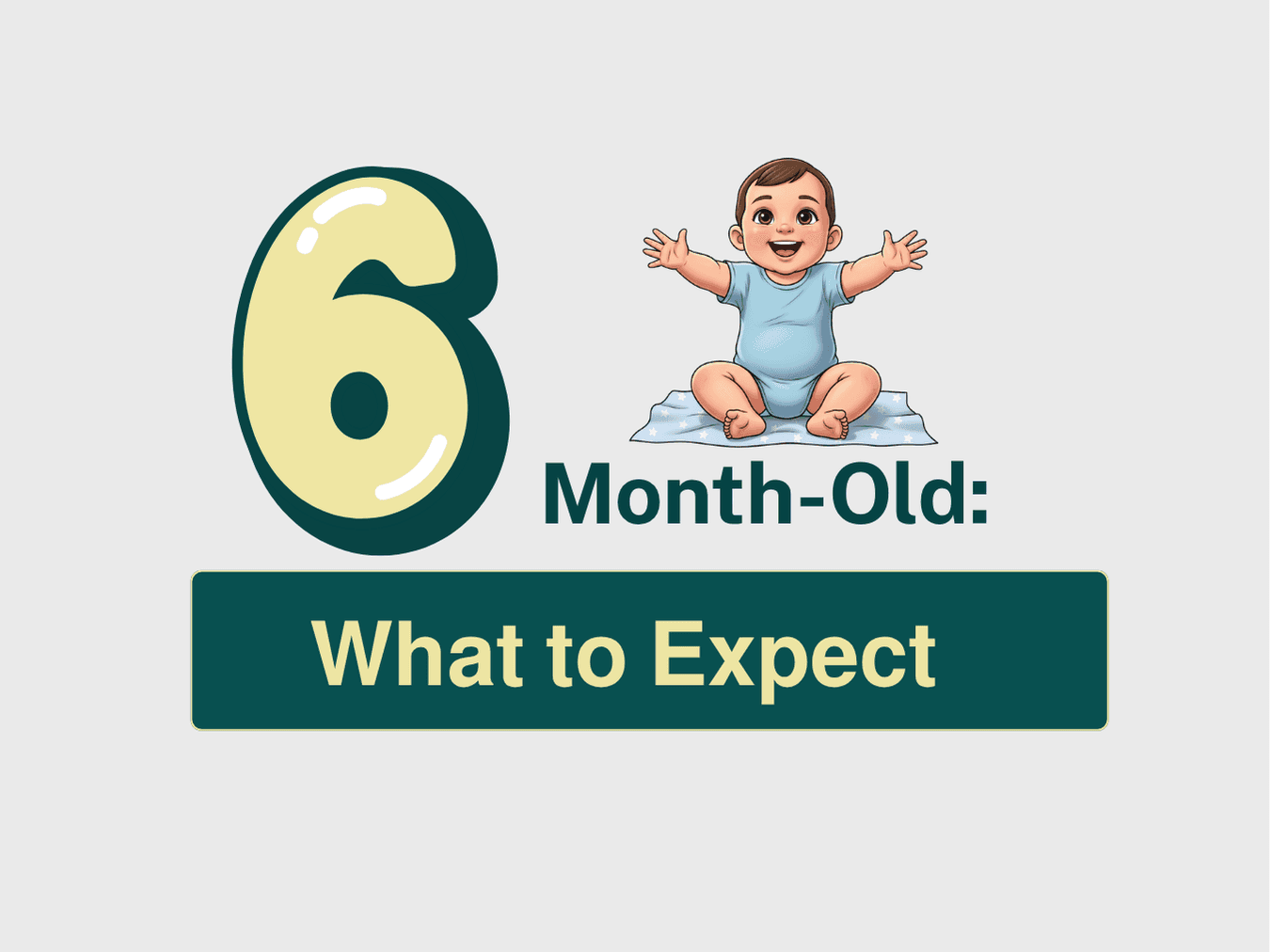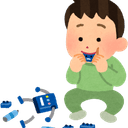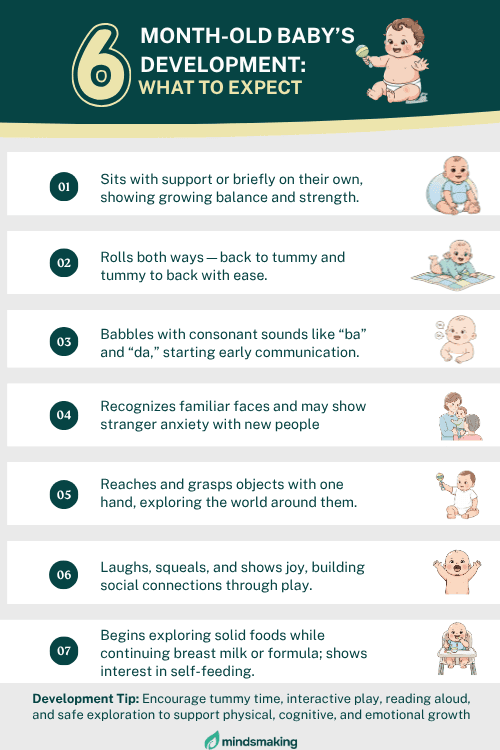6-Month-Old Baby Development and What to Expect

Written by Mindsmaking Medical Writer
Fact Checked by Mindsmaking Professionals
24th, November, 2025
From sitting up and reaching out to taking solids and discovering new tastes, your 6-month-old baby’s development is packed with surprises and fun.
It is hard to believe, but your baby has now reached the 6-month milestone and is halfway to their first birthday. Now, your baby has made their first sound, and this has even developed into coos and babbles. Luckily for you, the days of second night syndrome, irregular sleep schedule, and cluster feeding are no more.
By 6 months, your baby may shock you with a sudden response to their name, laugh at familiar faces, and show signs of baby motor skills, like rolling over and sitting without support. Your baby is starting to charm everyone with their growing personality.
For many parents, this is the period to introduce solids to their babies. This should be done with your doctor's guidance. Every baby develops at their own pace, but knowing the typical milestones at this stage can help you celebrate progress and know when to seek help.
Key Takeaways
By 6 months, your baby is developing strong muscles, improving coordination, and starting to practice movements that will lead to sitting, crawling, and eventually standing.
Your baby now shows curiosity, problem-solving, and social awareness, recognizing familiar faces, exploring objects, and engaging in playful interactions that build cognitive and social skills.
Your baby shows clear emotions, seeks comfort from caregivers, responds to their name, and displays early signs of joy, frustration, or stranger anxiety, all of which reflect growing emotional awareness.
Breast milk or formula remains essential, while introducing single-ingredient solids, iron-rich foods, and safe allergenic foods supports growth, self-feeding skills, and healthy nutrition.
At 6 months, babies can sit with support, roll over, babble, recognize their name, start solids, reach for objects, laugh, show separation anxiety, and explore their world actively.
Consistent sleep, tummy time, daily talking or reading, safe toys, and calm mealtimes support a 6-month-old’s physical, cognitive, and emotional development.
Watch for food allergies, choking hazards, teething or sleep disruptions, increased mobility, and appetite changes as your 6-month-old grows and explores.
Ensure teething care, baby-proofing, up-to-date vaccinations, safe sleep practices, and proper pacifier use to protect a curious and active 6-month-old.
Delayed rolling, weak head control, limited grasping, minimal sounds or social interaction, and unusual body movements can signal developmental concerns in a 6-month-old.
Physical and Motor Development
At 6 months, your baby is starting to feel like they run the show. Those tiny limbs are no longer just for wiggling, they now grab everything in sight and practice moves that might just lead to crawling. Every roll, sit, or kick is a little step ahead, and every new baby skill comes with wide-eyed pride for you. It is an exciting mix of “aww” moments, laughter, and the occasional “see what my baby just did!" Now, here is how your baby's development is going:
Physical and Motor Development

Sitting with Little to No Support
Your baby can now sit upright with minimal help, using hands at first and then eventually letting go. This development milestone shows that trunk and core muscles are growing strong. At this stage, it is fun to watch them twist, lean, or reach for toys with determination. Each attempt is a step toward your baby's independent sitting and playful adventures.

Rolling Over Both Ways with Ease
Now, your little baby is flipping around like a tiny acrobat. Each roll demonstrates stronger muscles, improved coordination, and a newfound sense of freedom. These rolls often come with giggles, wide-eyed stares, and moments when you cannot help but clap your hands together in delight at your baby's progress.

Rocking Back and Forth
Whether on hands and knees or sitting, you may notice gentle rocking. This is your baby probably practicing the motions needed for crawling. It is both a sign of growing strength and a reminder to baby-proof everything within reach.

Reaching, Grasping, and Object Transfer
Hand-eye coordination is now improving fast. Your baby can grab toys, shake them, bang them together, and pass objects from one hand to another with intent. Fine motor skills are getting serious at this stage, and most things still end up in the mouth. Every action is both play and skill-building for your baby, not reflexes.

Putting Weight on Legs When Held Upright
Hold your baby up and feel those tiny legs push back already. That is your baby testing balance, building leg strength, and practicing what will eventually become standing. It is their first “practice session” for walking, and you’ll be surprised by how strong those little legs are getting.
Cognitive and Social Development
By 6 months, your baby’s brain and social skills are in full swing. They are no longer just reacting, they are thinking, experimenting, and showing little personalities. Those tiny eyes are scanning for new adventures, and smiles reserved for favorite people. Here are some signs your baby’s social and cognitive development is leveling up at 6 months:
Recognizing Familiar People vs. Strangers: Your baby may smile and reach for you (or familiar faces) while pulling a wary face at strangers. Those first hints of stranger anxiety are a sign they are forming strong attachments to you. Now, they believe familiar faces are safe and feel uneasy around strangers. This shows baby recognition and development.
Curiosity About Surroundings: Expect deliberate reaching, grabbing, and exploring of objects around them. That little hand stretching for your coffee cup? Totally a “let me study this mysterious adult potion” moment. This shows your baby's brain is developing every day.
Exploring Cause and Effect: Dropped toys are not just accidents, but experiments. Your baby might bang two toys together or watch a rattle fall again and again, learning that their actions can make things happen.
Playtime Engagement: Giggles, squeals, and excited movements are your baby’s way of saying, “Yes! This is fun!” These reactions are not just cute, they help build social connections, teaching them about shared joy and encouraging interaction.
Early Problem-Solving Skills: Your baby might reach for a partially hidden toy, figure out how to manipulate it, or shake a rattle to see what happens. Each attempt advances their thinking, coordination, and creativity, supporting them to reach greater cognitive milestones.
Emotional Development
Your baby’s emotions are becoming more vivid and easier to read by 6 months old. They are learning who makes them feel safe, happy, or unsure, and every reaction gives you a peek into their emotional world. Here are signs of emotional development at this age:
- Your baby responds when they hear their own name, turning or looking toward you.
- Your baby shows clear joy, excitement, or frustration through smiles, squeals, or grumbles.
- Your baby seeks comfort from familiar caregivers, reaches for you when upset or needing reassurance.
- Your baby may show fear or cling to familiar caregivers when around new people, an early sign of stranger anxiety.
For babies, emotional reactions are a mix of adorable, amusing, and sometimes dramatic moments that reveal how they are starting to understand the world around them.
Read This Next
No posts available
Food and Nutrition
While breast milk or formula is still the superstar of your 6-month-old baby's nutrition, solid foods are now joining the party. This is the perfect stage to introduce new flavors, textures, and some early self-feeding fun. Here is everything you need to know about food and nutrition at this stage:
Signs your baby is ready for solids: Before introducing solids to your baby, ensure they can hold their head steady and sit up with minimal assistance. This means they’re ready to safely explore solid foods without choking hazards. Interest in feeding also matters. Your little one might lean toward your plate, grab at your spoon, or watch you eat with wide-eyed curiosity. That’s their subtle or not-so-subtle way of saying, “I want in!”
First Foods to Try: Start with single-ingredient purees and soft foods. Start simple with mashed fruits, soft-cooked veggies, or single-grain cereals. One new food at a time is the rule, allowing you to spot any allergic reactions.
Allergenic foods: Now, introduce allergenic foods slowly. With your doctor’s guidance, slowly add foods like eggs, peanut butter, or fish. Early exposure, done safely, can reduce allergy risks.
Encourage self-feeding: Offer your baby soft finger foods like ripe banana pieces or steamed carrots. Let your baby explore textures, practice pincer grasp, and get delightfully messy.
Iron-rich foods: You can also give them iron-rich foods. Think pureed meats, lentils, and iron-fortified cereals. Iron is critical at this age to support rapid growth and brain development.
Positive mealtime environment: Sit with your baby, make eye contact, and smile! Mealtime is as much about social bonding as it is about nutrition.
Be patient and persistent: Your baby might make funny faces or
refuse new food, but that is completely normal. Keep offering it multiple times; eventually, curiosity wins!
What to Avoid at 6-Month Old: Wait until after 12 months to introduce honey to your baby. It can carry bacteria that cause infant botulism. Cow’s milk as a drink should also be avoided until after 12 months. Before then, it does not have enough nutrients and can upset their tummy.
Risky Foods: Avoid salt, added sugars, and processed foods at 6 months. Keep your little one’s taste buds pure and healthy. Skip chips, sweets, and sugary drinks. Also, avoid unpasteurized dairy, raw eggs, and undercooked meats.
Important Milestones
At 6 months, your baby is no longer just a cute newborn, they are a tiny human with opinions, skills, and the occasional attitude. Here's what they are up to:
Sitting with little or no support - Your baby can now sit up like a pro with a little cushion backup, of course.
Rolling over easily both ways - One minute they are on their back, the next they are on their tummy.
Babbling with consonant sounds ("ba," "da") - They're not just cooing anymore, they are starting to talk.
Recognizing their own name- Say their name, and they might look at you.
Starting solids (if recommended by doctor) - This is the time most 6-month-old babies are introduced to the world of purees and mush.
Reaching for objects with one hand - They are not just grabbing, they are aiming with a single hand.
Laughing and showing joy - Their giggles are contagious. One smile from them, and your heart melts.
Showing early signs of separation anxiety - They love you so much, they cannot bear to be apart.
Exploring with hands and mouth - Everything goes in the mouth. It is their way of learning about the world.
Responding to familiar faces and voices - They know who you are, and they're not afraid to let you know with actions.
Routine Tips
If your 6-month-old baby's development is not keeping you on your toes, what will? As your baby is developing, routines can help support their progress and make daily life more enjoyable. Here are some tips that can aid your baby's development:
- Regular sleep schedules help them rest better and keep those adorable giggles coming, rather than cranky cries.
- Encourage tummy time and floor play for strength
- Read, sing, and talk daily for language growth.
- Offer safe toys, such as soft rattles or teething rings, to help develop motor skills, hand-eye coordination, and curiosity.
- Create a calm mealtime environment when starting solids to aid feeding.
Things to Look Out For
As your 6-month-old grows and explores, there are a few things to keep an eye on. While some are serious, some are just a little messy chaos. Here’s what to watch for:
Signs of food allergies: When introducing solids, watch for rashes, vomiting, or trouble breathing. A tiny “I’m not feeling great” signal might mean it’s time to pause and check with your doctor.
Choking hazards: Nuts, whole grapes, and hard chunks of food are a definite no-no. Safety first, even if it means they give you the puppy eyes when you snatch the snack away.
Sleep regressions or teething discomfort: Some nights might turn into full-blown concerts of fussing and crying. Keep teething toys handy and a patient smile. This is only temporary and will pass soon.
Increased mobility: Rolling, scooting, and reaching mean baby-proofing is a must. Anything within reach might become a new toy or snack. Think of it as a mini-adventure zone, but safer.
Growth spurts affecting appetite or sleep: Do not worry if your baby suddenly wants more milk or naps more. It is all part of growing fast. Your little one’s body is a work in progress, and you are along for the ride.
Health and Safety
It is all fun and beautiful to watch your 6-month-old baby develop into an active little chap, but this stage also comes with some health and safety issues to note. With their curiosity and energy growing by the day, keeping them safe can feel like a full-time mission. Consider these common health and safety tips to protect your little explorer while enjoying every giggle, wobble, and “look what I can do!” moment:
- Watch for teething symptoms like drooling, red gums, and chewing on everything in sight. Although these are messy, it means strong new teeth are on the way.
- Baby-proof everything because now outlets, cords, small objects, and wobbly furniture suddenly become hazards. Think of your home as a mini adventure park.
- Stay up to date with vaccinations by checking your schedule for 6-month shots, and keep up with them.
- Maintain safe sleep practices by always placing your baby on their back in a crib with a firm mattress and no loose items.
- Avoid weighted or unsafe sleep products. Skip heavy blankets, weighted swaddles, or anything that could cover their face.
- Pacifier safety, Pacifiers can soothe and comfort your baby, but ensure they are the right size and never attached to strings or cords.
Development Problem Signs
Even though watching your 6-month-old grow is filled with giggles, surprises, and proud moments, it is essential to stay alert for signs that something might require extra attention. Keep an eye out for these development warning signals:
- Not rolling over in either direction.
- Poor head and trunk control.
- Not reaching for or grasping objects
- Not making sounds or responding to voices
- Very stiff or very floppy body movements
- Limited social interaction
- Lack of interest in surroundings
- Difficulty with eye contact or tracking
Conclusion
Your baby is now halfway to one, marking the beginning of significant growth milestones. Celebrate this magical stage filled with curiosity, smiles, and first experiences with food. Cherish the babbles, playful moments, and growing personality, while remembering that every baby develops at their own pace. Stay attentive, trust your instincts, and enjoy this precious milestone.

Was this article helpful?
How many stars are you giving this article?
Leave a comment
Your email address will not be published.